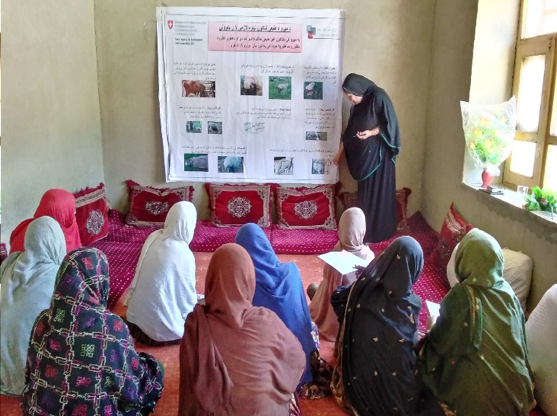Project Objective: Livelihood and resilience of resource-poor, and smallholder farmers[1] is sustainably improved in Paktia and Khost provinces of Afghanistan.
Outcomes:
- The productivity of resource-poor farmers ‘Income Generation Activities’ is enhanced
- CB-NRM associations halt degradation and manage common natural resources sustainably
- The productivity of smallholder farmers’ Land-based Agriculture’ is improved
- DAIL/PAIL strengthened to support resource-poor and smallholder farmers and deliver agricultural services
TLO-SLSD Project in Phase 1 and Phase 2 Majority Achievement:
The SLSD Project Phase 1&2 supported total 14,148 families in 14 targeted districts of Pitka and Khost provinces.
- This includes supporting 2,756 families in agriculture,
- 1,966 families in poultry farming and goat rearing,
- 5,695 families in irrigation system improvement,
- 3,731 families in access to safe and clean drinking water.
- Additionally, the irrigation system of 1,120 hectares’ agricultural land improved, 223 ha covered by NRM measures, 68,098 man-days of skilled and unskilled labor wages created for rural community members.
- Furthermore, 7,315 individuals (M/F) trained in hygiene and sanitation, 1,422 individuals in trained in NRM and DRR measures, 394 community members trained in technical aspects, 10,163 farmers in improved agriculture and livestock practices, 698 in construction activities, and 115 PAIL extension staff and AVA para vats capacity built in agriculture extension and livestock management activities.
- It is worth mentioning that two provincial conferences against deforestation in Paktia and Khost provinces were organized, and the establishment of Khost nursey association is supported by SLSD project as well.
TLO-SLSD Project in Phase 3 Majority Achievement:
Outcome Indicators:
- 1’043 resource-poor female farmers produce vegetable, dairy, or poultry products for home consumption, reducing their food insecurity months by 20%.
- 550 resource-poor farmers (M/F) increase their income by selling agriproducts (livestock, dairy, vegetable) and are linked to the market.
- 880 resource-poor farmers (M/F) (from earlier phases) are supported and have improved income as a result of access/linkage to market
- Vegetative coverage of 440 ha of common property land stabilized and managed sustainably
- Members of CB-NRM associations report a reduction of damage due to natural resource hazards of 20%
- Horticulture productivity of 1030 smallholder farmers (M/F) increased on average by 20%
- 1943 smallholder farmers (M/F) have increased crop productivity by 20% through irrigation system improvement (infrastructure and management)
- 500 smallholder farmers (M/F) report improved income as a result of market linkages
- 880 smallholder farmers (M/F) (from previous phases) are supported and have improved income as a result of access/linkage to market
- 89 DAIL staff from 25 districts and 2 PAIL staff from 2 provinces report having the necessary resources to support resource-poor and smallholder farmers
- 25 DAIL staff from 25 districts and 2 PAIL staff from 2 provinces report having been strengthened.
Output indicators:
- Three relevant private sector associations facilitated in sale and processing of livestock and horticulture products.
- 10 NRM stabilization and management plans developed, approved by the relevant associations and implemented on 1,200 ha common property land
- 10 CB-NRM associations registered and inclusively and sustainability managing common natural resources
- Three relevant private sector associations facilitate sale and processing of crop and horticulture products
- 11 water management/irrigation association (WM/IA) established and registered
- 2 PAIL offices at the provincial level and 39 DAIL offices at the district level are equipped to visit and support farmers
- NRM specialist and extension officers fielded and provided rural advisory services in all 25 targeted districts
- On average a 20% increase in the pre and post-training KAP survey results
- Two Farmer Learning & Resource Center established in Paktia and Khost province





















